Photography is the art of freezing the moment. With the advent of photographic equipment, this became available to many, with the beginning of the era of digital photography - to everyone, regardless of gender and age. In order to make good SIM cards, you need to have a decent camera. The most popular devices on the Russian market are the company's products Canon... It accounts for 44% of all cameras purchased by Russians. However, any professional will tell you that 70% success in this business depends on the lens and only 30% on the carcass. The editors of the site "bestx.htgetrid.com/en/" offers readers a review of "The Best Lenses for Canon Cameras for 2020", based on customer reviews and expert recommendations.
Content
- 1 Pinhole camera
- 2 Heliography and daguerreotype
- 3 First photographic lens
- 4 Optics choice for CANON cameras
- 4.1 How to decipher the marking
- 4.2 Full frame and crop factor
- 4.3 Focal length designation
- 4.4 Aperture designation
- 4.5 Luxury segment
- 4.6 Optical Image Stabilizer
- 4.7 Autofocus motor
- 4.8 Hinge of light filters
- 4.9 Closest focusing distance
- 4.10 What else should you pay attention to
- 4.11 Portrait photography
- 4.12 Shooting a landscape
- 4.13 Sports and wildlife
- 4.14 Macro photography
- 4.15 Shift lens
- 4.16 Which lens is better to buy?
- 5 Rating of quality lenses for Canon cameras
- 5.1 10. Canon EF-S 18-55 mm f3.5-5.6 IS STM
- 5.2 9. Canon EF 28 mm f / 2.8 IS USM
- 5.3 8. Canon EF 100mm f / 2.8 Macro USM
- 5.4 7. Canon EF 17-40 mm f / 4 L USM
- 5.5 6. Canon EF 28 mm f / 1.8 USM
- 5.6 5.Sigma AF 8-16 mm f / 4.5-5.6 DC HSM Canon EF-S
- 5.7 4. Canon EF 135 mm f / 2 L USM
- 5.8 3. Canon EF 100 mm f / 2.8 L Macro IS USM
- 5.9 2. Canon EF 35 mm f / 1.4 L II USM
- 5.10 1. Canon EF 70-200 mm f / 2.8 L II IS USM
Pinhole camera
The progenitor of photographic equipment was the camera obscura (lat. - dark room). It became known about it back in the fifth century BC, thanks to the Chinese philosopher Mo-tzu, who told people about the appearance of images on the wall in a dark room, when a beam of light passed through a small hole into it. A little later, Aristotle described the principle of its work. In the 10th century, with its help, the Arab mathematician Alhazein proved the linearity of the propagation of light rays. In the 13th century, Roger Bacon "discovered" it again.
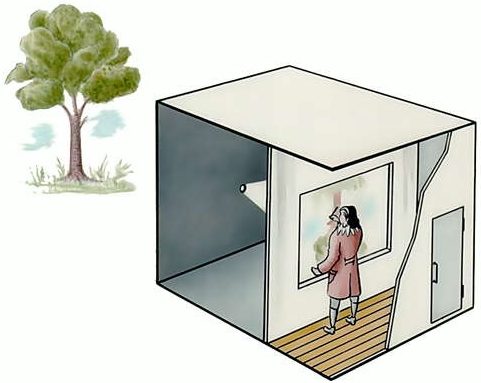
Practical application of the camera obscura was found by artists, and the first of them was the great Leonardo da Vinci. It was a dark room with a small hole in the wall. The rays of light passing through it projected an inverted image of an illuminated object or landscape onto the opposite wall, so clear and saturated that the artist could only trace its contours and color the resulting image, while preserving shadows, tones and midtones.
Many famous painters used this "tool" to paint pictures, which required a detailed drawing of furnishings, architectural details. True, not everyone was happy with the inverted image.
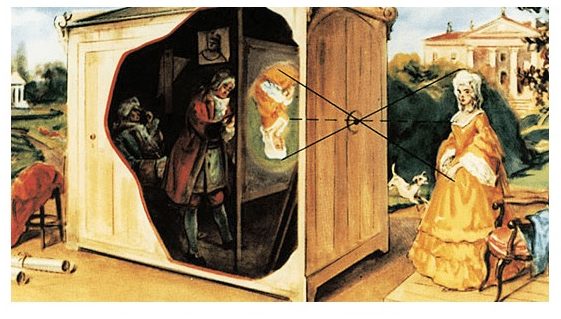
The medieval monk of the Order of Premonstrants, Johannes Tsan, managed to solve this problem. After carefully working on the works of Leonardo, he created in 1686 a portable version of the camera obscura, equipping it with a mirror located at an angle of 45 degrees to the light beam. The projection in the apparatus of the learned monk appeared on a horizontal matte plate, from which it was much more convenient for the artist to copy the already unturned image onto paper.
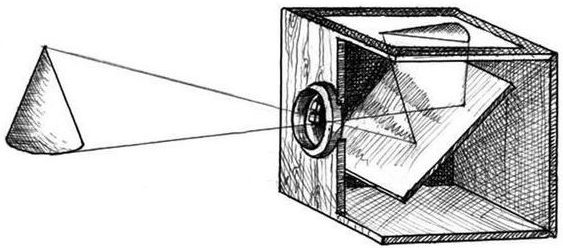
Heliography and daguerreotype
The first photograph in a camera obscura was taken by the Frenchman Nesipor Niepce.

Interesting! Not possessing the gift of drawing, Niepce wanted the sunlight to work for him.In 1926, after years of experimenting with different compositions, he managed to get a photographic image of the view from the window of his workshop. Niepce called this picture heliography.
Niepce's contemporary and compatriot Louis Daguerre, on the contrary, was a talented artist. While working at the Ambipo Comic Theater, he experimented with the scenery depicted on huge translucent canvases, changing their lighting with the help of many mirrors. There was no limit to the delight of the audience.
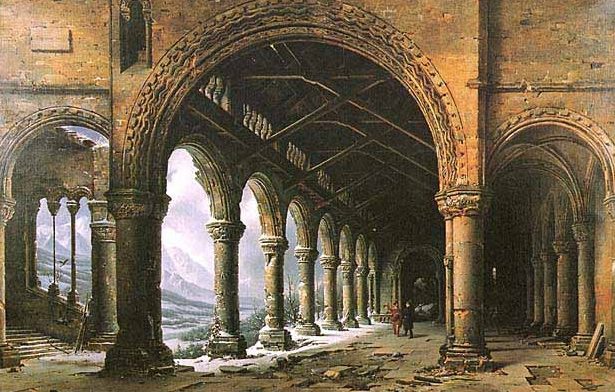
Daguerre painted fragments of his dioramas using a camera obscura. He wanted to fix the images obtained on the glass. Charles Chevalier, who prepared the lenses for him, brought Daguerre and Niepce together. Their joint research led to equipping the obscura camera with a photosensitive plate, i.e. to the appearance of the first camera.
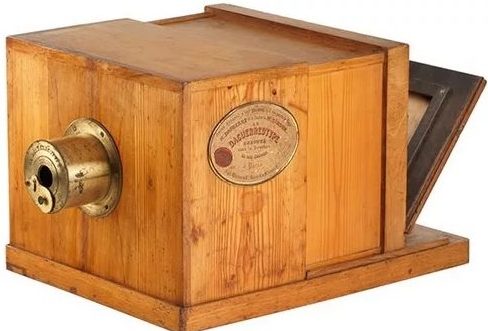
The pictures taken with the Daguerre apparatus were called daguerreotypes.
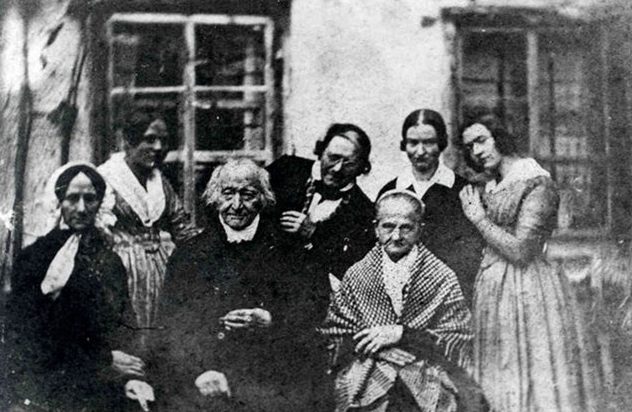
First photographic lens
The French optician Charles Chevalier, the same one who brought Niepce and Daguerre together, together with his father, the owner of the optical workshop, was engaged in the manufacture of lenses for microscopes, telescopes, and the deposition of glasses for sunglasses. Father and son assembled the first apparatus for Niepce's experiments, made obscura cameras for Daguerre. My father invented a lens for a pinhole camera. The son perfected it. In addition, Charles invented his own drawing apparatus - the lucid camera.
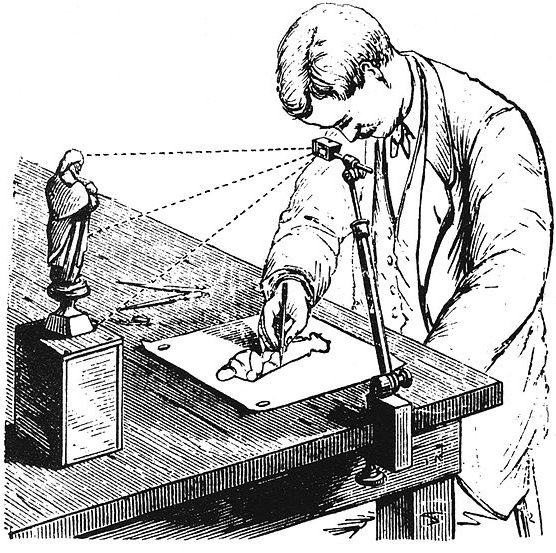
The first photographic lens was developed by Charles Chevalier in 1839. It was a lens - an achromatic meniscus. Chevalier assembled it using a biconcave lens made of optical glass with a high refractive index (flin), and a biconcave lens with a low refractive index (crowns). In the same period, he invents the iris diaphragm, with metal blades.
Interesting! In 1849, Chevalier received a gold medal at an exhibition in Paris for photographs of Pyatigorsk with its surroundings, taken with his lens. The author of the photographs was the famous Russian photographer S.L. Levitsky. In 1877, Levitsky and his son were awarded the title of court photographers "Their Imperial Majesties."

Optics choice for CANON cameras
A modern photographic lens is a complex optical device, which includes:
- optical elements consisting of spherical, aspherical and low dispersion lenses;
- optical stabilizer;
- autofocus motor;
- diaphragm.
To determine the criteria for choosing high-quality optics for a digital camera, you should familiarize yourself with some of their technical characteristics and capabilities. This information is contained in the labels on the lens.
How to decipher the marking
All glasses have inscriptions in which their main characteristics are encrypted. You need to be able to read and understand them. For Canon, the best will be "native" glass from the same company. Thus, the first inscription that we will look for will be the word "CANON".
There may be inscriptions indicating the type of shooting. The word "MACRO" means a special glass designed for shooting objects at a scale of 1: 1, or even larger (this is also possible). The word "LENC" means that we are dealing with a lens, not binoculars or a telescope. Thus, the inscription CANON MACRO LENC indicates that we have a lens from CANON for large-scale shooting.
Full frame and crop factor
Digital cameras can be full-frame or cropped. These two concepts appeared in the everyday life of photographers with the advent of digital cameras. The width of ordinary photographic film is 35 mm, the standard frame was 35 x 24 mm (we do not consider wide-format film cameras here).
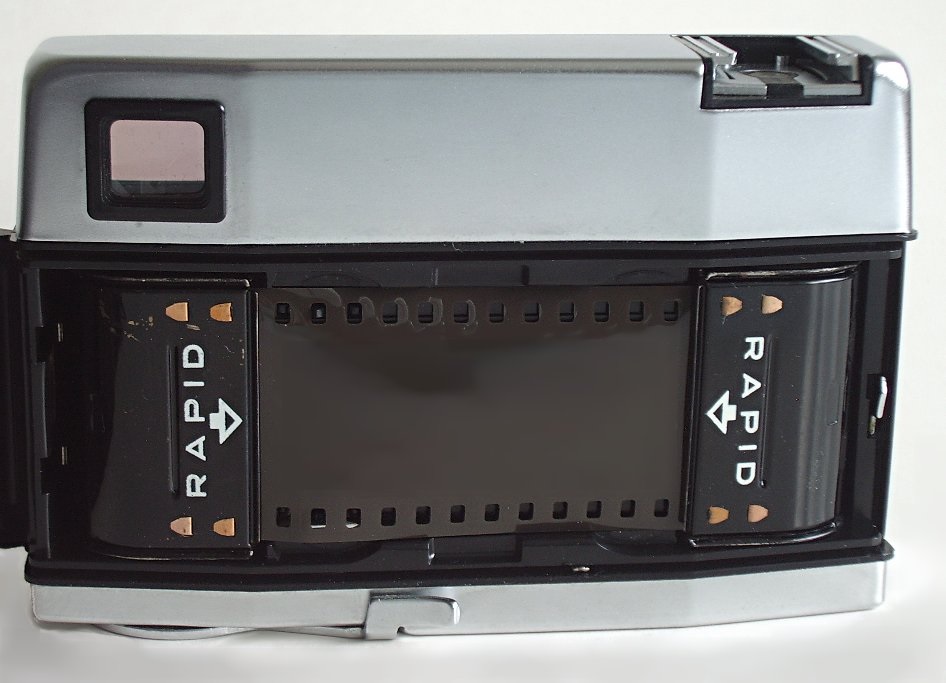
In a digital camera, the film was replaced by a photosensitive matrix. Its dimensions can correspond to a standard 35 x 24mm film frame.These cameras are called full-frame cameras. Cameras with a smaller sensor are called "cropped", from the English word crop (cut).
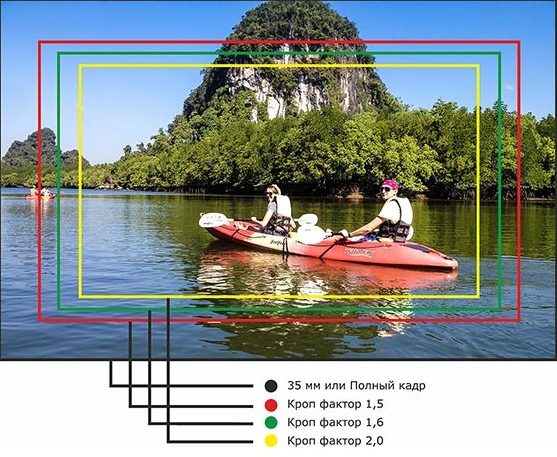
The EF designation is specific to the Canon camera mount (body optics dock equipped with contacts for electronics). Simply EF - tells us that this lens is designed for full frame 5D, 6D and 1D cameras. However, they can be installed on other Canon cameras, including crop ones. The letters EF-S mark the glass of the crop only.
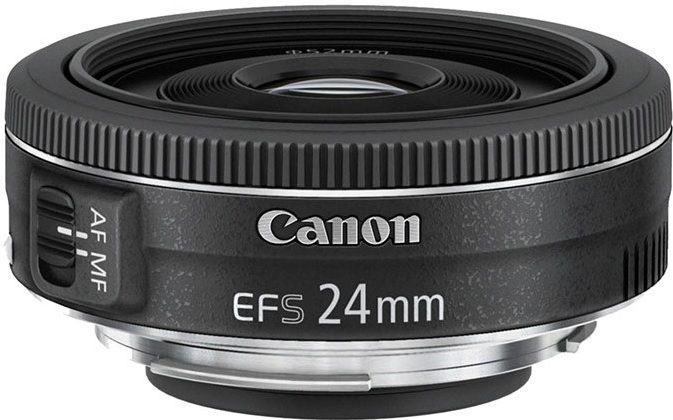
We can talk about the pros and cons of both types for a long time. Some people like full-frame cameras, others work exclusively with crop and are not going to change it. One thing is for sure: full-frame cameras are much more expensive than a crop.
Focal length designation
The distance from the plane of the lens to the camera matrix is called the focal length. It is very important to understand that this is not a characteristic of a camera, but of a lens. Measured in millimeters. Examples of designation: 35 mm, 50 mm, 100 mm.
There are two groups of lenses:
- zoom - with variable focal length;
- fixes - with constant focus.
The focal length of the fixtures is indicated by one number: 35 mm, 50 mm, etc. The lower the number, the larger the field of view. Lenses with focal lengths up to 50mm are called wide-angle lenses because they can cover a very large area in the frame. Optics with a field of view of more than 90 degrees are called ultra wide-angle.
A fifty-millimeter fix is called normal, since it shows without distortion what the human eye sees.
Optics with a focal length of more than 70 mm are called telephoto. The longer the focal length, the smaller the angle of the field of view. If this parameter exceeds 300 mm, the optics are called super long focus.
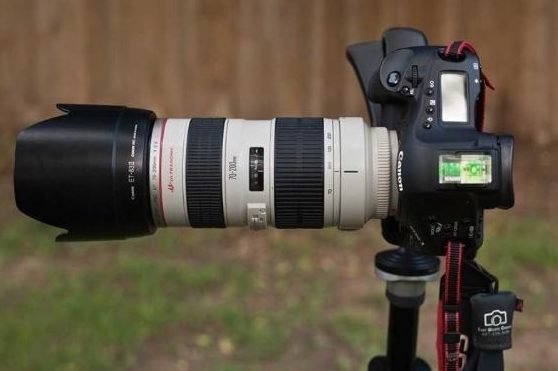
Fixes lack Zoom. You can zoom in or out on the subject only by moving towards the subject for close-up photography, or moving away from it to get a wide shot.
The focal length of the zoom is a variable value. Example of designation: 70-200 mm. By rotating the zoom ring, we change the angle of view, which makes it seem like the object is visually getting closer or farther away. Professional photographers skillfully use the power of zooms and fixes to "play" with the perspective and proportions of objects.
Aperture designation
The aperture ratio is designated by numbers 1: 5.6; 1: 2.8; 1: 1.2, etc. This parameter shows the maximum amount of light that the lens can let through. The smaller the number after the colon, the higher the luminosity of such glass. For example, an aperture ratio of 1: 1.2 is more than 1: 5.6. High-aperture glasses are preferable. With them, you can take high-quality pictures in low light at long shutter speeds without using the flash or using a tripod.
Interesting! In order to take pictures of the far side of the Moon, NASA used the specially made, fastest in the world Carl Zeiss Planar 50mm f / 0.7 lens with aperture of 1:07. A total of 10 of them were produced.
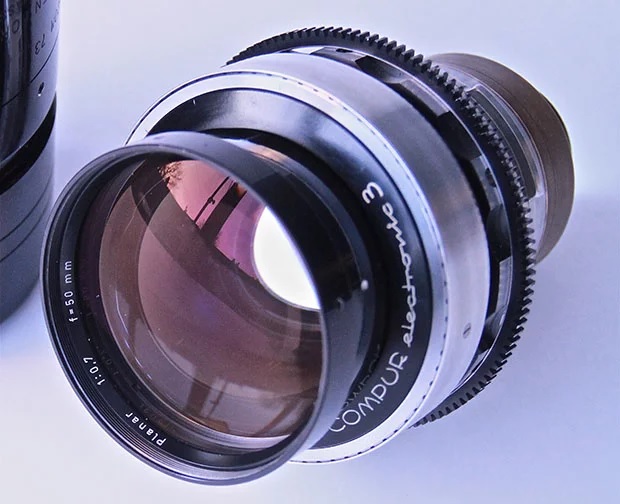
Fixes always have a constant aperture ratio. For zooms, the aperture ratio can be indicated by two numbers, for example, f 3.5 / 5.6. This means that at the minimum focal length, you can fully open the iris (position 3.5). If you reduce the angle of view by visually bringing the subject closer to you by scrolling the zoom ring, the aperture will automatically close to 5.6, reducing the aperture. To compensate for the lack of light in the frame, you will have to either increase the exposure (shutter speed), or raise the ISO (the sensitivity of the matrix).
Luxury segment
Laksheri, from the English "Luxury" - luxury, means that the lens belongs to the most expensive, highest quality product. If you see the letter L and a red rim on the case, you should know that this is a very expensive thing. These optics are always equipped with dust and moisture resistant and the best lenses available at the moment. Such glasses give a contrasting image, perfectly reproduce colors, and do not distort anything.
Optical Image Stabilizer
A very useful device.It eliminates the "blur" of images from natural shaking hands, which is especially important for owners of heavy cameras, or during extended shooting, when the hands get tired, or when shooting at slow shutter speeds without a tripod. Stabilization is activated by a special button on the case.
Autofocus motor
USM indicates the type of autofocus motor. With these optics, there is no need to focus manually. The autofocus motor will operate automatically and the image will be guaranteed to be in focus. The USM motor makes some noise during operation. When recording videos, the owner will have to use an external microphone so that the motor noise is not recorded. Instead of USM, you can see the inscription STM. This means that the autofocus is equipped with a silent motor. A camera with autofocus function adapted for video recording.
Hinge of light filters
There is a thread on the front edge of the lens for attaching a light filter. In order not to be mistaken with its dimensions, its diameter is indicated, for example, Ø 50 mm.
Closest focusing distance
It is indicated in meters. Indicates the minimum distance you can move the camera closer to a subject to get a shot in focus. If you get closer to the minimum distance, autofocus will not cope with its task and you will not be able to get a good picture. This parameter is important for those who like to shoot small objects in close-up. The corresponding designation of the minimum focusing distance can be applied to the focusing ring or displayed in a special window on the lens barrel.
What else should you pay attention to
CANON lenses always have a switch for automatic and manual focusing, which are indicated by the letters AF and MF. Select automatic (AF) mode, point the camera at the subject and press the shutter halfway. The camera starts to catch focus automatically. When the focus is caught, push the shutter button to the end. For manual mode, move the button to the MF position.
Portrait photography
The best lenses for portraits are prime lenses. The most budget fixed has an aperture of f / 1.8. The best zoom can never be faster than f / 2.8. Feel the difference! Due to the higher aperture, the fixes give a more blurred background, which is very important for a portrait. Finally, fixes have the best lenses. They provide better color rendition and withstand backlight better. This is explained by the simplicity of the fix device, in comparison with the zoom. There are no moving parts, less glass, less reflections at the lens-air interface, less distortion.
The best glasses for portrait photography have focal lengths of 50, 80, 100, 135 mm. These are long-focus fixes. Wide-angle prime produces significant distortion, resulting in increased detail closest to the lens. The portrait can be made with an enlarged nose, forehead, cheeks or eyes. If you need not a portrait, but a cartoon, you can use wide-angle optics.
Shooting a landscape
The prime lens for landscape photography is the prime lens. If we compare a prime and a zoom of the same cost, then the prime will always be of higher quality and will produce images with greater sharpness and better light transmission than a zoom. But it so happens that a photographer with a fixed lens will not be able to approach the subject at the required distance, or unwanted objects fall into the frame. It becomes necessary to slightly reduce the angle of the field of view. A wide-angle zoom like 16-35mm, 17-40mm can help here. The quality of the picture will be excellent, but not the maximum (not for sale).
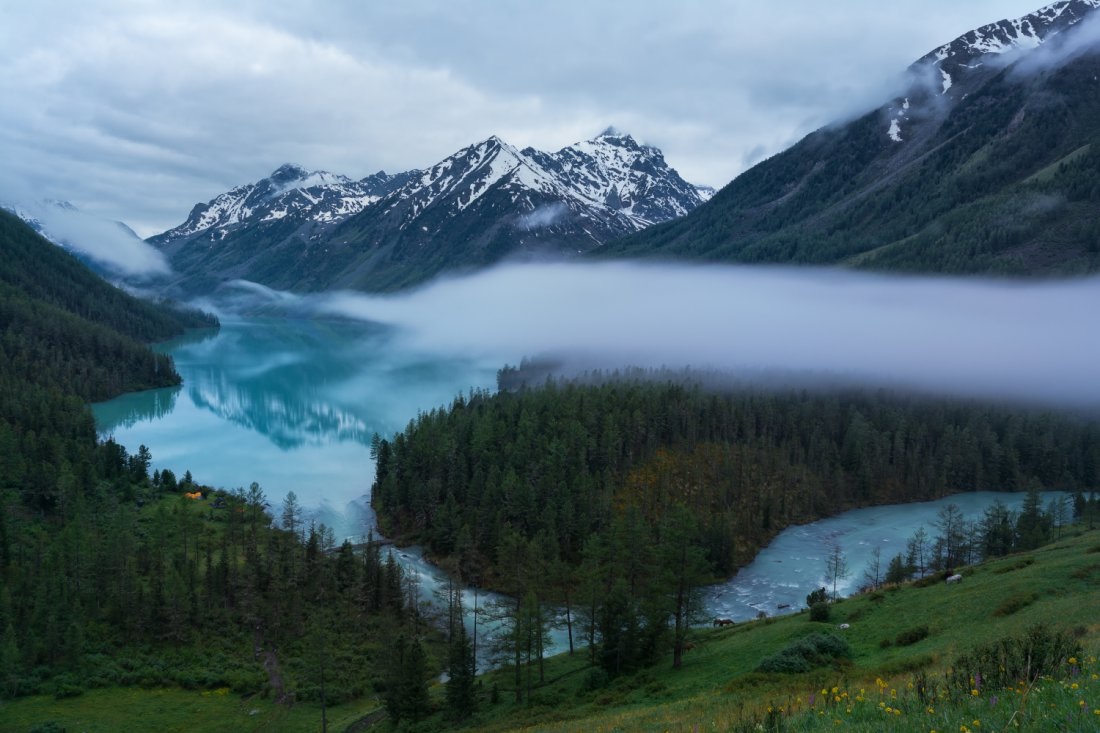
Sports and wildlife
For these purposes, long-focus and ultra-long-focus optics are used. Sports reporters use the EF 400 mm f / 2.8 L IS USM most often. As you can see from the marking, here we are dealing with an ultra-long-focus prime of the luxury segment, with a good aperture ratio (f / 2.8), an optical voltage stabilizer and a USM autofocus motor.

Macro photography
Everyone has ever admired large-format shots of flowers or insects. A macro lens is used for such shooting. These are special optics with focal lengths from normal (50 mm) to 180 mm. The image of a small object is taken over the entire frame.The EF 100 f / 2.8 Macro is very popular and loved by the EF 100 f / 2.8 Macro, with a minimum focusing distance of 31 cm. It allows you to take pictures of the subject in life size, with excellent sharpness and color reproduction.
Shift lens
An interesting tool, with the ability to shift and tilt around the optical axis. If perspective distortions appear when shooting architectural objects, they can be corrected by shifting the optics relative to the frame window or tilting it relative to the optical axis. Shear-only optics are labeled PC (Perspective Correction). The lens, which can also change the tilt angle, is marked with TS (Tilt and Shift). Example - Canon TS-E 45 mm f / 2.8. Shifts are expensive, at least $ 1000.
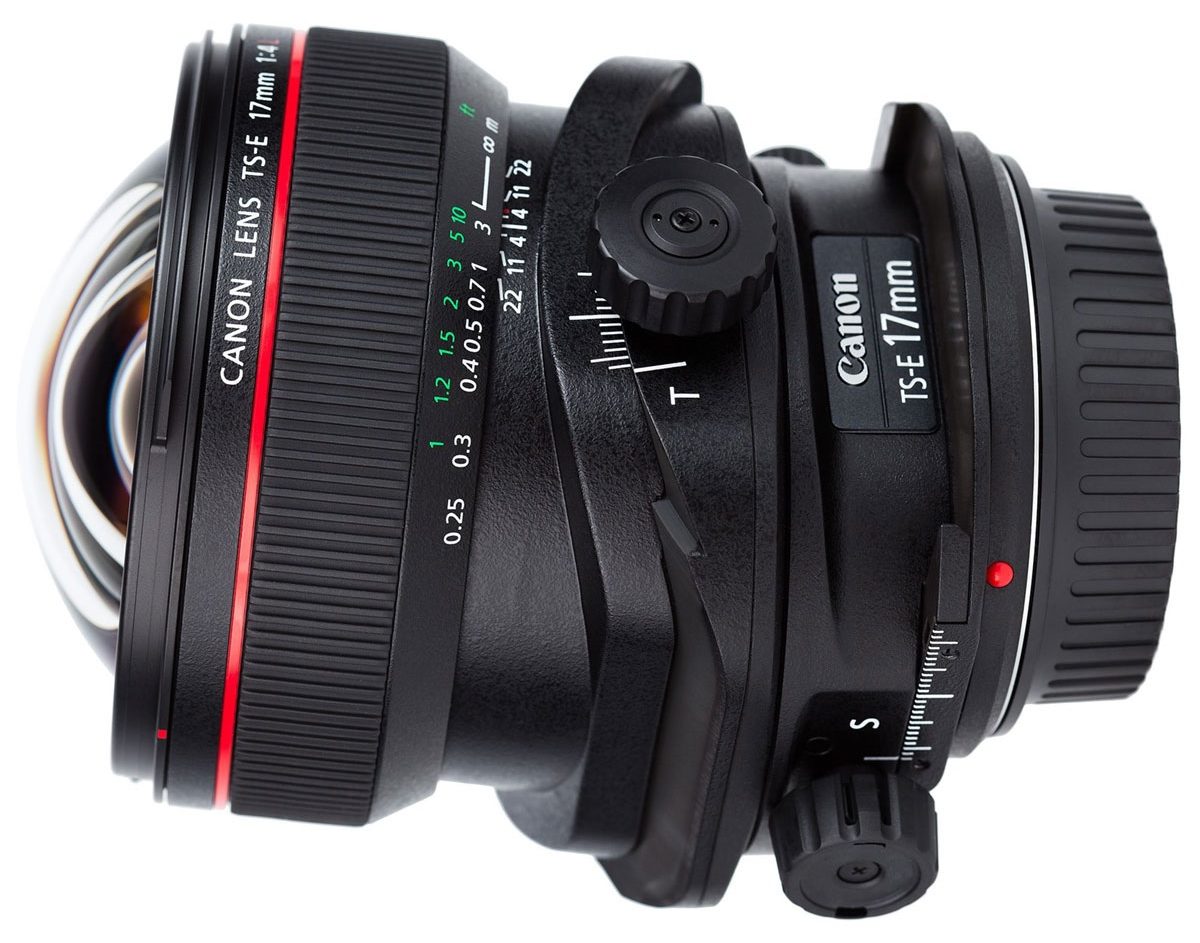
Which lens is better to buy?
In addition to the native glass, the CANON camera can be equipped with optics from third-party companies. Consider a few of the best manufacturers.
The products of the Japanese company Sigma are most often used. Its inexpensive glasses, practically not differing in quality from CANON products, are significantly inferior to them in price. True, not everything is smooth here with color reproduction. Sigma products give warmer tones. The skin and foliage of trees take on a yellowish tint. Budget samples can give a gray coating. But this can be corrected with a graphical editor.
Less common are Tamron optics. The products of this Japanese company require testing because several of the same lenses can be made with different qualities. For the price, Tamron products are somewhat more expensive than Sigma.
There are also optics from the Japanese company Tokina, the American Vivitar and the German Soligor. They are extremely rare in our market. So the best alternative to CANON lenses is Sigma optics. However, if the budget allows, the best option for a CANON camera would be native hardware.
Rating of quality lenses for Canon cameras
10. Canon EF-S 18-55 mm f3.5-5.6 IS STM
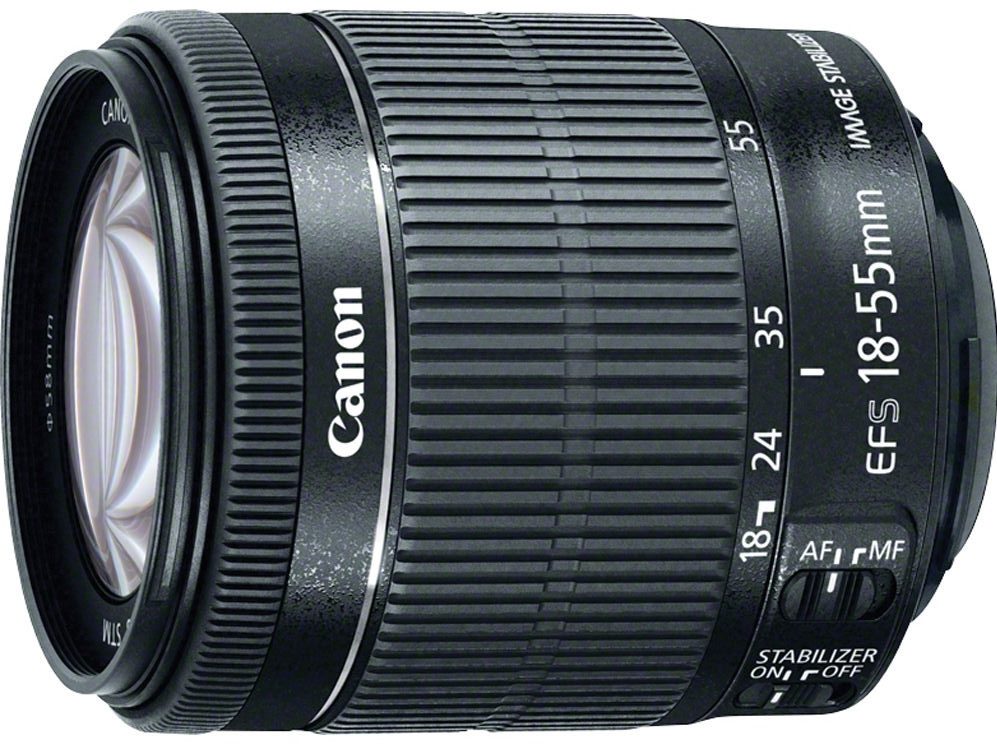
Opens the zoom range for cameras with 18-55mm crop factor and variable focal lengths. Suitable for beginners as a regular glass. For indoor shooting, aperture is not enough, but this is leveled by shooting with a tripod and flash. The quality of the pictures, subject to these conditions, is simply excellent. High speed autofocus when shooting video. STM motor runs silently. Average price: 5250 rubles.
Advantages:
- good sharpness;
- excellent color rendering;
- image stabilizer;
- fast autofocus;
- affordable price.
Disadvantages:
- little aperture.
| Lens model | Specifications | average price |
|---|---|---|
| Canon EF-S 18-55 mm f / 3.5-5.6 IS STM | Zoom lens with variable focal length from 18 to 55 mm, viewing angle 27.5 - 75.2 degrees min., Minimum focusing distance - 25 cm. Designed for work with partial-frame cameras. Aperture parameters - 3.50-5.60, number of blades -7. There is an optical stabilizer. Silent STM autofocus drive. The lens can be equipped with 58 mm color filters. | 5250 rubles |
9. Canon EF 28 mm f / 2.8 IS USM
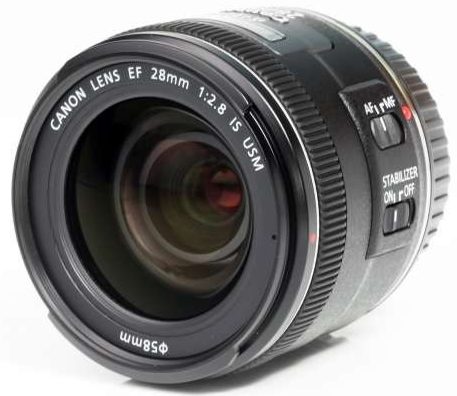
The ninth position is occupied by a wide-angle prime with an aperture of f / 2.8. This is not the largest indicator among the fixes, but optics with such a diaphragm are counted among the fast ones. The device has all the necessary functionality and excellent optical parameters to obtain high quality images. Designed to work with a full-frame camera, producing excellent landscape shots. It proved to be excellent as a staff on cropped cameras. The optical stabilizer is really good. Autofocus is fast and sharp. Average price: 30,950 rubles.
Advantages:
- compact size;
- light weight;
- excellent image quality;
- fast autofocus;
- excellent stabilizer.
Disadvantages:
- high price for this functionality.
| Lens model | Specifications | average price |
|---|---|---|
| Canon EF 28mm f / 2.8 IS USM | Wide-angle prime lens with a focal length of 28mm, a minimum focusing distance of 23 cm, aperture of 2.8 mm. Designed to work with full frame cameras. Equipped with optical stabilizer and USM autofocus motor. Optical elements - 9, groups of optical elements - 7. Weight 260 g. Light filters with a diameter of 58 mm are suitable. | 30950 rubles |
8. Canon EF 100mm f / 2.8 Macro USM
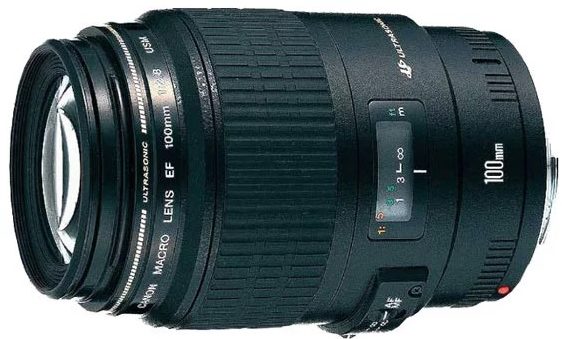
On the eighth place in the review is the lens for macro photography. All its charms are indicated in the labeling. It is a telephoto prime with an ultrasonic autofocus motor. Designed to work with a full frame camera. It is with it that you can get pictures of insects or flowers at a scale of 1: 1 for the entire frame. With this glass, you can shoot macro, portrait, use it as a telephoto lens. The depth of field is shallow, so it's best to work with a tripod. Excellent sharpness, pleasant bokeh, minimal distortion. Autofocus is fast, quiet and accurate. Some are saddened by the lack of a stabilizer, but do not forget that this glass is sharpened for macro photography, and a stub will not help in this genre. Average price: 28,300 rubles.
Advantages:
- excellent sharpness;
- high detail;
- decent luminosity;
- nice bokeh.
Disadvantages:
- small depth of field.
| Lens model | Specifications | average price |
|---|---|---|
| Canon EF 100mm f / 2.8 Macro USM | Long-focal prime lens for macro photography, with a focal length of 100mm, an angle of view of 24 degrees, a minimum focusing distance of 31 cm, aperture f / 2.8. Dimensions 79x119 mm, weight 600 g. Optical elements 12, groups of optical elements - 8. Equipped with an ultrasonic autofocus motor, thread for a light filter, 58 mm in diameter. Works with full frame and crop cameras. | 28,300 rubles |
7. Canon EF 17-40 mm f / 4 L USM
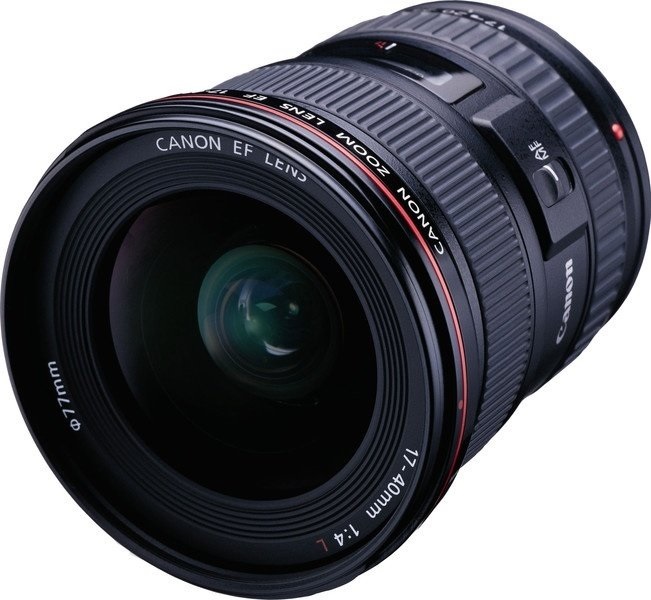
The first L in our review. Ultra-wide-angle zoom with low aperture and USM autofocus motor. There are few who will look for flaws in the optics of the luxury segment. Excellent durability, highest quality optics and assembly. High contrast and excellent color reproduction. The autofocus is very accurate and does not miss. Reliable protection against dust and moisture ingress. With him - even under water. Many consider this glass as a staff, but this is not entirely true. These are specialized, high-end optics for landscape photography. Its excellent qualities are fully revealed with a full-frame camera. Convenient case and lens hood included. The price for L-ki is not high, on average - 31400. According to buyers - the best ratio of price, quality and functionality.
Advantages:
- very durable;
- all-weather;
- image quality is excellent;
- fast and accurate autofocus;
- dimensions and weight do not bother;
- acceptable price.
Disadvantages:
- they simply do not exist.
| Lens model | Specifications | average price |
|---|---|---|
| Canon EF 17-40 mm f / 4 L USM | Wide-angle zoom lens with a variable focal length from 17 to 40 mm, aperture of f / 4, a minimum focusing distance of 28 cm, an angle of view from 54 to 107 degrees. Can work with full-frame cameras and crop. There are 12 optical elements, groups - 9. Dimensions 83.5 x 96.8 mm. Weight 500 g. Ultrasonic autofocus motor. Dust and moisture protection. | 33,990 rubles |
6. Canon EF 28 mm f / 1.8 USM
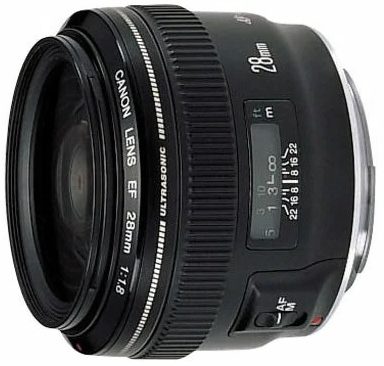
The sixth line is occupied by a wide-angle fast fixed. Users appreciate it for its compactness and light weight, high aperture, wide angle, excellent image quality. Blurs the background perfectly. This is a great landscape painter, but full-length portraits come out very well. The diameter of the filter thread - 58 mm is very common, it is not difficult to pick up any one. Sims are sharp, color rendition is excellent. The USM autofocus motor works flawlessly. Average price: 32,240 rubles.
Advantages:
- fast and accurate autofocus;
- large aperture;
- wide viewing angle;
- high-quality pictures;
- compactness.
disadvantages
- there is not enough lens hood included.
| Lens model | Specifications | average price |
|---|---|---|
| Canon EF 28 mm f / 1.8 USM | Wide-angle prime lens with a focal length of 28 mm, aperture f / 1.8, an angle of view of 75 degrees, a minimum focusing distance of 28 cm. There are 10 optical elements, groups - 9. Autofocus with USM motor. Dimensions 73.6 x 55.6 mm, weight 310 g. Thread for a light filter with a diameter of 58 mm. | 32240 rubles |
5.Sigma AF 8-16 mm f / 4.5-5.6 DC HSM Canon EF-S
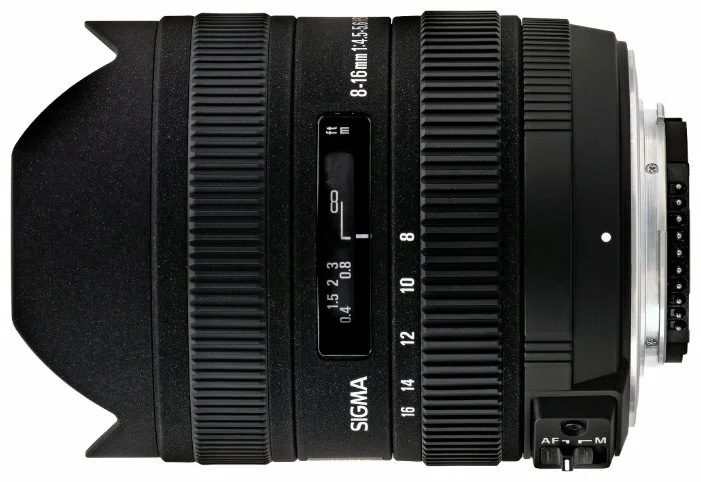
In fifth place is the first and only non-native glass for Canon cameras in our review. This is a Sigma product, ultra wide-angle zoom is not the largest aperture. The markings indicate that the mount for this glass is for small-frame cameras.Very good for taking pictures of landscapes and views, especially for those who like to travel to ancient cities in Europe. Everything that you want to capture will fit into the frame. There is no optical stabilizer, but at such focal lengths it is not needed. Average price: 44,990 rubles.
Advantages:
- excellent sharpness;
- saturated colors;
- the widest viewing angle, almost like a fisheye;
- high-quality assembly.
Disadvantages:
- lack of thread for a light filter.
| Lens model | Specifications | average price |
|---|---|---|
| Sigma AF 8-16 f / 4.5-5.6 DC HMS Canon | Wide-angle zoom lens with a variable focal length from 8 to 16 mm, with Canon EF-S mount for sub-frame cameras, with an angle of view from 75 to 114 degrees, minimum focusing distance 0.24 m. Optics: three aspherical + four low dispersion elements. Dimensions - 75 x 105.7 mm, weight 555g. Ultrasonic autofocus motor. | 44,900 rubles |
4. Canon EF 135 mm f / 2 L USM
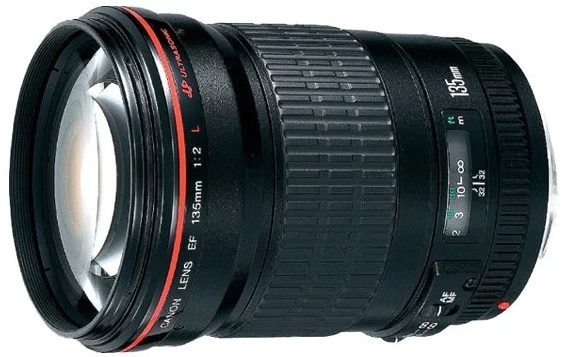
The fourth line was taken by another L-ka. Long-focus prime for full-frame cameras, fast, with USM autofocus motor. You don't have to worry about the build quality. The coveted red stripe and the letter L on the case speak for themselves. The quality of the pictures is amazing, even if they were taken in passing. It is considered by many buyers to be the best Canon lens. Color rendition, bokeh, sharpness are beyond praise. Great "portraitist". Fast and tenacious autofocus allows you to capture sports and action scenes.
Advantages:
- sharpness across the entire field;
- fast and accurate autofocus;
- amazing sharpness;
- excellent color rendering;
- protection from dust and moisture;
- durable body material.
Disadvantages:
- not identified.
| Lens model | Specifications | average price |
|---|---|---|
| Canon EF 135 mm f / 2 L USM | Telephoto lens with a fixed focal length of 135 mm, a minimum focusing distance of 90 cm, an angle of view of 18 degrees. Optics: 10 optical elements. Incl. 2 low dispersion lenses, collected in 8 groups. Designed to work with full-format cameras and crop. USM autofocus motor. Dimensions 82.5 x112 mm, weight - 750g. The lens can be equipped with 72 mm thread filters. | 48870 rubles |
3. Canon EF 100 mm f / 2.8 L Macro IS USM
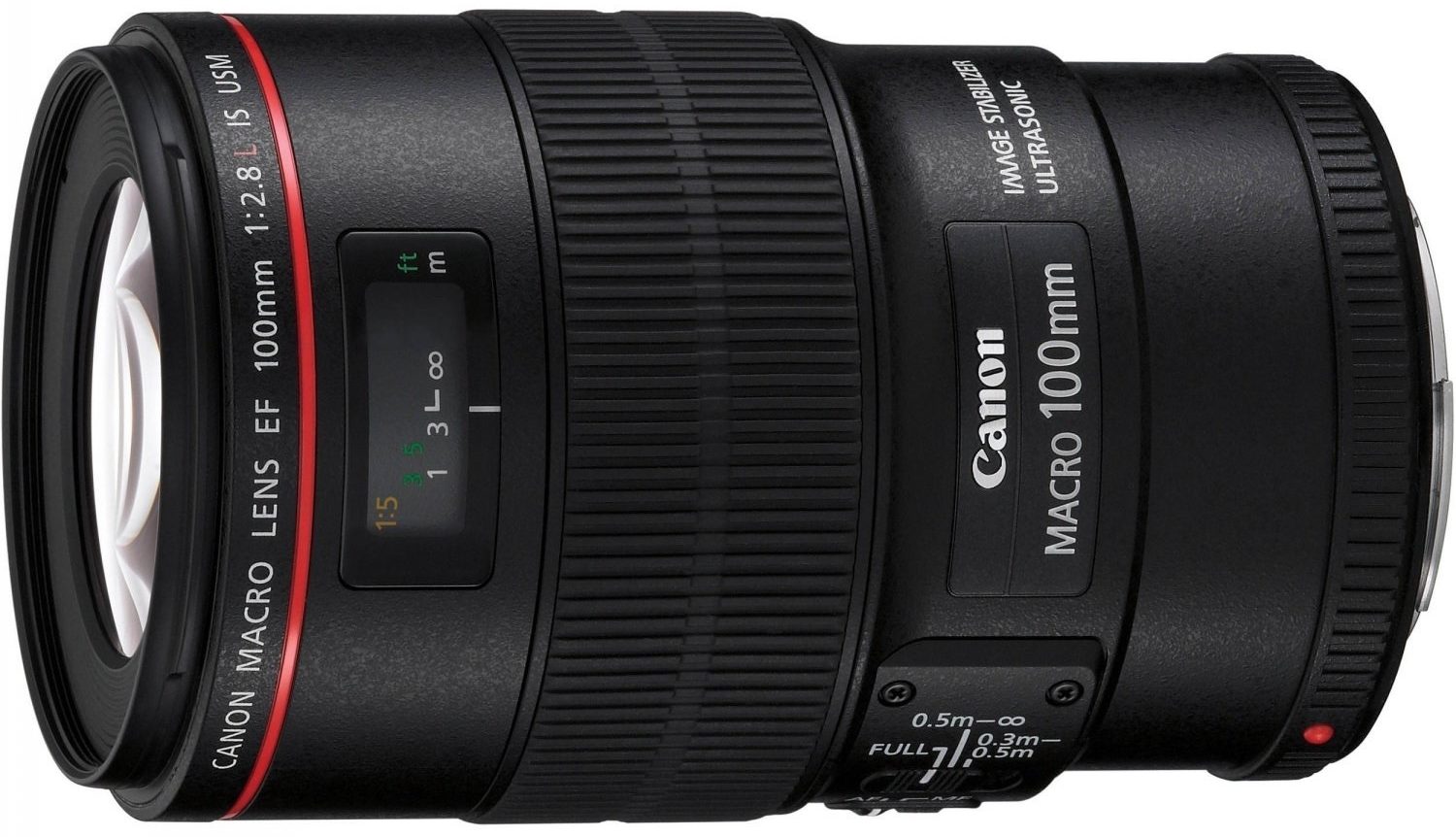
The third line is occupied by a long-focus prime with a decent aperture of f / 2.8. Other parameters speak for themselves. This is a macro glass. The quality is traditionally excellent, the optics are high-class and all-weather, with an optical stabilizer and a USM autofocus motor. His specialization is large format photography. However, he does an excellent job with portraits and reporting. In short, this is a universal optics, very sharp, especially at a closed aperture, with excellent color reproduction and almost no distortion. Buyers love the excellent gimbal, fast 3-position autofocus. Average price: 46,990 rubles.
Advantages:
- high build quality;
- excellent optics;
- excellent sharpness and color rendering;
- protection against dust and moisture penetration.
Disadvantages:
- if there is, only the price.
| Lens model | Specifications | average price |
|---|---|---|
| Canon EF 100 mm f / 2.8 L Macro IS USM | A long-focus macro lens with a fixed focal length of 100 mm, a minimum focusing distance of 30 cm. 15-element optics arranged in 12 groups. Dimensions 77.7 x 123 mm. Weight 625 g. Autofocus with USB motor. Designed to work with full frame cameras. Can work with crops. Equipped with a built-in optical stabilizer. | 46890 rubles |
2. Canon EF 35 mm f / 1.4 L II USM
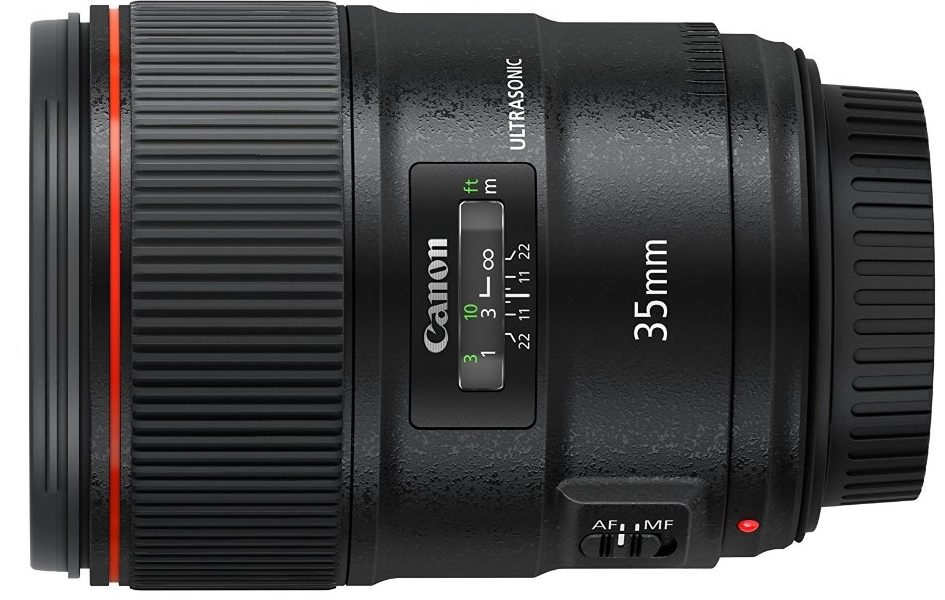
In second place is a fast prime with a 35mm focal length and a USM autofocus motor. Marking II informs us that this is already the second, improved version of this glass. The product is remarkable for its ideal focal length. In most cases it can be used as a "staff". Autofocus is quieter and faster than the earlier version. It also performs better in the dark than its predecessor.There are no chromatic aberrations. Plus all the delights of the L-segment quality: durability, all-weather, high-class optics. It will show itself perfectly when shooting landscapes, full-length portraits, outdoors. Average cost: 86,990 rubles.
Advantages:
- lack of chromaticity;
- large aperture;
- excellent sharpness;
- all-weather;
- strength and quality assembly.
Disadvantages:
- very high price.
| Lens model | Specifications | average price |
|---|---|---|
| Canon EF 35 f / 1.4 L II USM | Wide-angle fast prime lens with a focal length of 35 mm, a minimum focusing distance of 0.28 m. The optics includes 14 elements, collected in 11 groups, incl. Two aspherical and one low dispersion lens. Dust and moisture-proof housing with dimensions 80 x 106 mm, weight 760 g. 9-blade diaphragm. There is a thread for a light filter with a diameter of 72 mm. Autofocus with USM motor. | 86990 rubles |
1. Canon EF 70-200 mm f / 2.8 L II IS USM
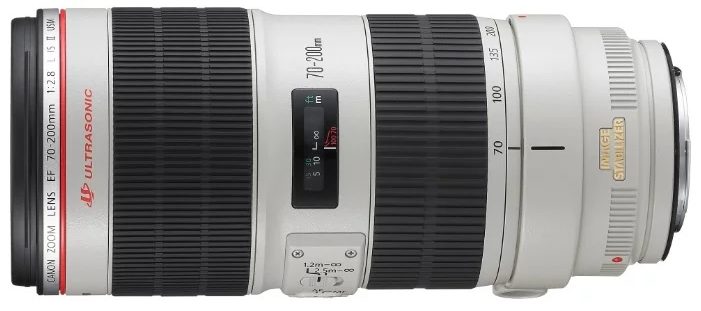
The first line and the best reviews is received by the high-aperture zoom of the L-segment, with an optical stabilizer, USM autofocus motor, variable focal length 70-200mm. Already by these parameters it is clear that the lens is unique. The viewing angle varies from almost normal to telephoto. At the same time, the sharpness is excellent for such a zoom, even with an open aperture. Aperture f / 2.8 is the fastest for zoom. The stabilizer is reliable and really prevents waste. Plus excellent optics, durability and weather resistance. A very decent glass for a very decent price. The average cost of this miracle: 95,500 rubles.
Advantages:
- fast and accurate focusing;
- excellent stabilizer;
- excellent sharpness.
Disadvantages:
- the price is not for everyone.
| Lens model | Specifications | average price |
|---|---|---|
| Canon EF 70-200 mm f2.8 L IS II USM | A telephoto zoom lens with a variable focal length of 70-200mm, aperture f / 2.8, a minimum focusing distance of 1.2 m. 8-blade aperture. Optics: 23 optical elements arranged in 19 groups. Low dispersion lenses in the amount of 5 pcs. Optical stabilizer and USM autofocus motor. Dust and moisture resistant. Dimensions 88.8 x 199 mm. Weight 1490 g. | 91,017 rubles |
Buying quality digital camera optics is not a cheap pleasure. The line of glasses for Canon is quite extensive. In order not to throw money away, you need to firmly know what you want to shoot and for what purposes. For the "soul" you can pick up something at an affordable price. Expensive glasses are worth buying if you are going or have long been "ripe" for the activity of a professional photographer. In any case, before making your choice, you should study the types, advantages and capabilities of lenses, find out what kind of shooting they are intended for. Which one is better to buy is up to you, but it will never hurt to listen to the advice and recommendations of professionals. Carefully study the instructions and description of the glass you have chosen, find out how much it costs. We hope that our review will help you not to make mistakes when choosing.












